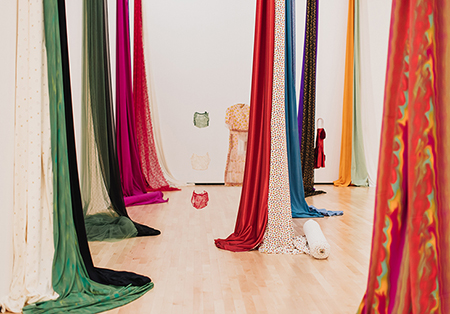
Continuing through August 13, 2023
The proliferation of Chicano art in the half-century since “Los Four” mounted major installations at UC Irvine in 1973 and at LACMA in 1974 has mined the culture and activism of contemporary Chicanos, along with references to their Aztec and other roots. Texas-born Celia Álvarez Muñoz’s artistic vision goes beyond traditional Chicano iconography. Her work combines the symbols and storytelling of Chicano art genre with conceptualism. Employing painting, sculpture, bookmaking, photography and text, she unearths memories of cultural immersion in multilingual El Paso, Texas where she grew up without losing sight of her Chicana identity.
Álvarez Muñoz (b. 1937) also infuses her work with reverence for the nurturing she received from her mother, aunt, and grandmother while her father was off at war. Her maternal grandmother related many stories of their family’s migration from Jalisco, Mexico, to El Paso, and witnessing gunfights of the Mexican Revolution from the rooftops.
With her family’s blessings, Álvarez Muñoz attended a high school across town, affording her art classes and pointing the way to studying art in college. Following graduation, marriage, motherhood and moves around the country, she returned to Texas at age 40, soon after enrolling at North Texas State University to study conceptual art and bookmaking, working toward an MFA.
In 1981, to fulfill a class assignment, she created a performance piece, making herself into an art professor, lecturing to her class. She then announced that a pre-conquest site had just been discovered in Mexico City, that an artifact had been found there, and that she was presenting it to the class. The artifact was a plumed mask she created from a World War II-era gas mask, embellished with brightly-colored feathers and beads.
Continuing her performance, Álvarez Muñoz claimed that the mask belonged to the previously unknown Aztec god, “Petrocuatyl.” That invented word combined the English prefix for gasoline and the Nahuatl word for serpent: it alluded to the Western world’s veneration for oil, along with its history of racism and colonialism. That long-ago performance is represented here by the Cibachrome print, “Petrocuatyl” (1988), with explanatory text and relevant imagery from “National Geographic.” It is a highlight of this exhibition of 35 artworks.
Two compelling installations are “Fibra y Furia” and “Fresas” (both 1997). Focusing on the over-sexualization of females by the fashion industry, these conjoined displays begin with a backdrop of large bolts of colorful fabric hanging down from the museum ceiling. Displayed among the fabrics are a macabre bridal gown, decorated with decaying leaves and vines, a red prom dress with exaggerated heart breasts sewn onto it, several pairs of very brief, jaggedly cut denim shorts with the crotches covered with red sequined fabric and lacy panties. Included also is a demure housewife dress, complete with apron, it sums up a culture that assigns women their domestic places.
Near these two displays is a mixed media vanity table, covered with the powders, rouges and tools that women use when making themselves up. “Chameleon” (1986) symbolizes the artist's reverence for her eccentric Aunt Lulu who loved to make herself up, and more importantly who recognized Álvarez Muñoz’s artistic talents early on by gifting her with a set of colored pencils. Suggesting that making art and applying make-up are linked, the artist pays homage to her aunt.
Three installations in her “Enlightenment” series include the mixed media “Which Came First?" (1982), "Ave Maria Purísima," (1983), and "La Honey" (1983). “Enlightenment” refers to Álvarez Muñoz’s finally committing herself, somewhat late in life, to the pursuit of art professionally. These conceptual pieces are constructed as artist’s books that contain cryptic language and photographs, addressing language, puberty, and sexuality. Her stories are about coming of age on the El Paso/Ciudad Juárez border.
The boldly executed “El Límite” (1991) combines memories from the artist’s visually rich childhood. Composed of large photos on vinyl of sardine-can toy trains, carrying food and other tools of survival, with text rising from the trains, this piece references her father’s youth spent train hopping and later riding trains during World War II. Part of the text reads, “Stories by Dad came from two sources; invented and real-life adventures. At times hard to separate or distinguish ... My favorite stories dealt with the War, when he was moved across the world and throughout Europe, again, mostly by train ... near the railroad tracks, they played with toys made out of things that don’t belong together.”
On the lighter side, “Lana Sube” (1988) is an installation of paired metal street signs, humorously alluding to the anglicized versions of Latino street names, alongside the often-spoken “Spanglish” versions of the names. The anglicized sign “El Paso St” is paired with “Il Peso St.” “Myrtle Rd” is paired with “Muertos Rd.” “Mesa St” is paired with “Maysa St.” A large painting of a brightly decorated home completes the installation.
Álvarez Muñoz’s art merges storytelling with conceptual elements. Their visual construction and narrative intentions are multifaceted. Yet it is their autobiographical aspects, their spirit of paying homage and expressing gratitude for the people and community that nurtured Álvarez Muñoz, that shine through.
